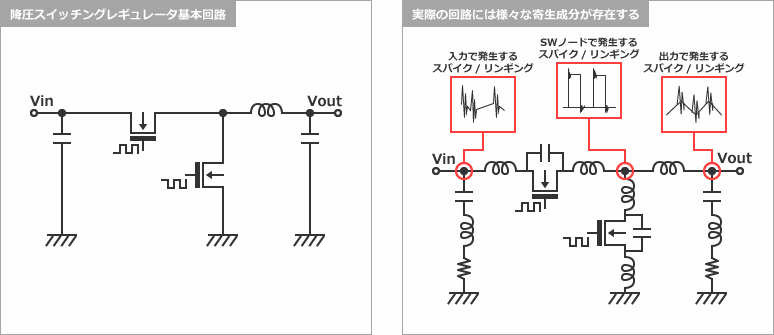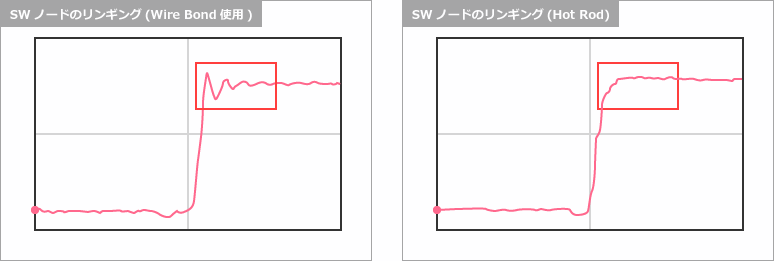Are you having trouble with noise countermeasures for switching regulators?
As you all know, a switching regulator is a type of DC-DC converter that converts direct current (DC) voltage to a different value of DC voltage and outputs it. It is characterized by extremely high conversion efficiency and low heat generation, but it also has the disadvantage of being noisy.
Switching regulator noise
Taking a step-down switching regulator as an example, the circuit consists of input and output capacitors, FETs, and inductors, as shown in the basic circuit below. This FET alternately performs ON/OFF switching operation, making it possible to generate an output voltage that differs from the input voltage level.
Due to the switching operation of the FET, a voltage waveform called ripple appears in the output in the form of a triangular wave with the same period as the switching frequency, but in an actual circuit, high-frequency spikes and ringing also occur.
These high-frequency spikes and ringing are caused by various parasitic components in capacitors, FETs, wiring patterns, etc., and may affect peripheral circuits as noise.

General noise countermeasures
The following methods are generally used as countermeasures against high-frequency switching noise.
- Layout pattern optimization
- Add BOOT resistor to suppress SW node overshoot and ringing level
- Add a snubber circuit to suppress SW node overshoot and ringing level
*Addition of BOOT resistance and snubber circuit causes a slight decrease in efficiency.
Improved power circuit performance through package innovation
At Texas Instruments, a package called Hot Rod™ enables performance improvements in power circuits, including noise reduction.
The Hot Rod package has a structure that does not use the wire bonding used in conventional packages by directly attaching the die to the lead frame. Elimination of wire bonding minimizes parasitics inside the package, lowers noise levels, improves efficiency, and reduces package size.
Comparison of QFN and Hot Rod packages

SW node ringing comparison

Hot Rod Package Power Products from Texas Instruments
Texas Instruments can provide power supply solutions with a rich product lineup. See the links below for details on each product.
Device with Hot Rod package
Click here for other Hot Rod product lineups
If you would like more information about the Hot Rod packages introduced in this article or TI products, please contact us here.
Click here for recommended articles/materials
Configure a power supply circuit with simple external components! Synchronous buck DCDC converter TPS568215/TPS56C215
Why does DDR memory need a dedicated power supply?
What is WEBENCHR -Overview-Engineers talk about easy-to-use points
How to use WEBENCHR - Power supply design - Basics (1) - Function introduction
Click here to purchase products
Click here for manufacturer site/other related links
Hot Rod QFN Application Note
Reduce EMI and Shrink Solution Size with Hot Rod Packages: Video

